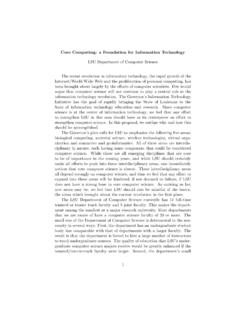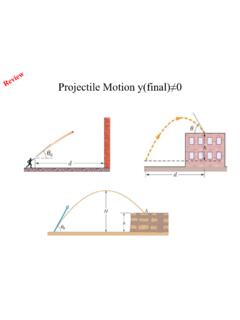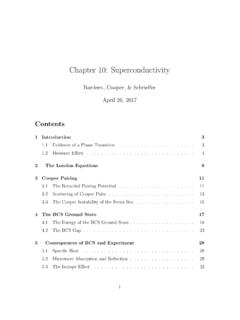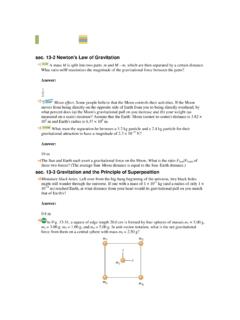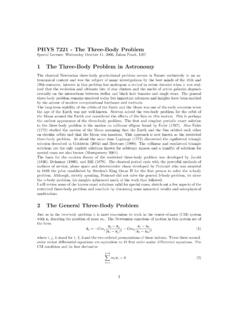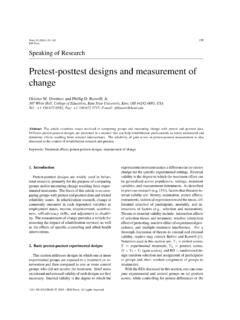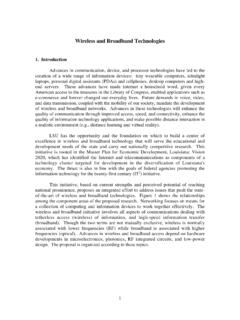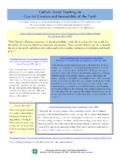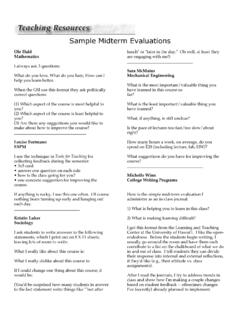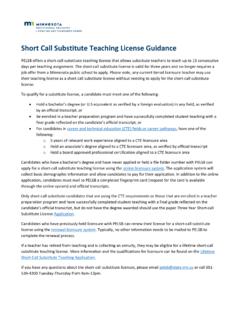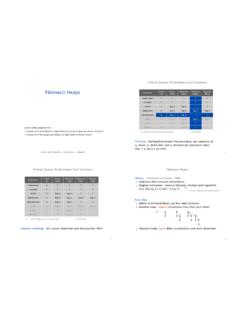Transcription of Single and Double plane pendulum - LSU
1 Single and Double plane pendulumGabriela Gonz alez1 IntroductionWe will write down equations of motion for a Single and a Double plane pendulum , followingNewton s equations, and using Lagrange s 1: A simple plane pendulum (left) and a Double pendulum (right). Also shown arefree body diagrams for the forces on each Newton s equationsThe Double pendulum consists of two massesm1andm2, connected by rigid weightlessrods of lengthl1andl2, subject to gravity forces, and constrained by the hinges in the rodsto move in a plane . We choose a coordinate system with the origin at the top suspension1point, the x-axis as a horizontal axis in the plane of motion, and the y-axis pointing down(so that gravity forces have positive components). The Single plane pendulum , a simplercase, has a Single particle hanging from a rigid ConstraintsThe simple pendulum system has a Single particle with position vectorr= (x,y,z). Thereare two constraints: it can oscillate in the (x,y) plane , and it is always at a fixed distancefrom the suspension point.
2 Mathematically,z= 0(1)|r|=l.(2)The Double pendulum system has two particles (N=2) with position vectorsr1,r2, eachwith components (xi,yi,zi). There are four constraints: each particle moving in the x-yplane, and each rod having constant lengths. These constraints can be expressed asz1= 0(3)z2= 0(4)|r1|=l1(5)|r2 r1|=l2(6)These constraints are holonomic: they are only algebraic relationships between the coor-dinates, not involving inequalities or the Single pendulum case, we only have one particle (N=1), so we have 3N=3 coor-dinates. Since we have two constraints (m=2), we are left with n=3N-m=3-2=1: only onegeneralized coordinate. This is the angular position of the pendulum , which we can useto write:r=l(sin ,cos ,0).(7)In the Double pendulum We know there should be only two generalized coordinates,since there are 3N=6 coordinates, and m=4 constraints, so n=3N-m=6-4=2. We can findexpressions forr1,r2in terms of two angles 1, 2:r1=l1(sin 1,cos 1,0)(8)r2=r1+l2(sin 2,cos 2,0)(9)We can express velocity an acceleration vectors in terms of generalized coordinates.
3 Forthe Single pendulum ,2r=l(sin ,cos )(10) r=v=l (cos , sin )(11) r=a=l (cos , sin ) l 2(sin ,cos )(12)=l v l 2 r(13)The velocity vectorvis perpendicular to the position vectorr, which is the expressionof the constraint|r|=l= constant. We should recognize the tangential and centripetalacceleration terms, proportional to the velocity and to the inverted radial directions, the Double pendulum , we derive the same expressions for the first particler1=l1(sin 1,cos 1)(14) r1=v1=l1 1(cos 1, sin 1)(15) r1=a1=l1 1(cos 1, sin 1) l1 21(sin 1,cos 1)(16)=l1 1 v1 l1 21 r1(17)and the second particle:r2=r1+l2(sin 2,cos 2)(18) r2=v2=v1+l2 2(cos 2, sin 2)(19) r2=a2=a1+l2 2(cos 2, sin 2) l2 22(sin 2,cos 2)(20) ForcesIn the Single pendulum case, the forces on the particle are gravity and tension. Gravityis along the y-direction, or the direciton of gravitational accelerationg, and the tension ispointing towards the origin, along the direction of r:F=T r|r|+mg= Tlr+mg(21)In the Double pendulum , the forces onm1are the tension in the two rods, and tension in the upper rod is along the direction r1, the tension force onm1due tothe lower rod is along the directionr2 r1, so we can write the forceF1asF1=T1 r1|r1|+T2r2 r1|r2 r1|+m1g= T1l1r1+T2l2(r2 r1) +m1g(22)The forces onm2are the tension in the lower rod, and gravity.
4 The tension onm2isalong the direction of (r2 r1):F2=T2 (r2 r1)|r2 r1|+m2g= T2l2(r2 r1) +m2g(23) Equations of Single PendulumIn the Single pendulum case, Newton s law isF=m r. Writing the two non-trivial compo-nents, we havem r=F= Tlr+mg(24)ml( (cos , sin ) 2(sin ,cos ))= T(sin ,cos ) +mg(0,1).(25)We thus have two equations:ml( cos 2sin )= Tsin (26) ml( sin + 2cos )= Tcos +mg(27)Notice that although we only have one generalized coordinate ( ), we have two equa-tions. That is because the equations also have the magnitude of the tension as an unknown,so we have two equations for two unknowns, equations are not only coupled, but are also non-linear, involving trigonometricfunctions (ugh!). A common trick with expressions involving trig is to make use of trigidentities like cos2 + sin2 = 1. For example, multiplying 43 by cos , and adding Eq. 45multiplied by sin , we obtain a simpler equation for . Using these identities, we canwrite the equations asl = gsin (28)ml 2=T(29)We cannot solve Eq.
5 28 analytically, but we could either solve it numerically, or in thesmall angle approximation. There will be two constants of integration, because it is asecond order differential equation: we can relate those constants to the initial position andvelocity, or to conserved quantities such as the total energy (but not linear momentum,nor angular momentum: the forces and torques are not zero!). Whichever way, once wehave a solution for (t), we can use it in to solve for the other unknown, the tensionT. does not invovle derivatives ofT, so there are no new constants of integrationfor the Double PendulumIn the Double pendulum , Newton s second law on each particle isFi=mi ri:m1 r1= T1l1r1+T2l2(r2 r1) +m1g(30)m2 r2= T2l2(r2 r1) +m2g(31)4 Are these six equations (each equation has three componsents) for two coordinates 1, 2?Again, not quite: the equations only have two non-zero components in the x,y plane , andwe have four unknowns: 1, 2,T1and T2, so we have four equations for four unknowns,just as write the equation of motion for the two particles, split into their two componentsin the plane :m1l1( 1cos 1 21sin 1)= T1sin 1+T2sin 2(32) m1l1( 1sin 1+ 21cos 1)= T1cos 1+T2cos 2+m1g(33)m2(l1 1cos 1 l1 21sin 1+l2 2cos 1 l2 22sin 2)= T2sin 2(34) m2(l1 1sin 1+l1 21cos 1+l2 2sin 2+l2 22cos 2)= T2cos 2+m2g.
6 (35)We have then four differential equations, for four unknowns ( 1, 2,T1,T2).Trigonometric identities such as cos2 + sin2 = 1, and sin 2cos 1 cos 2sin 1=sin( 2 1) can be used to write the equations of motion as:l1 1= (T2/m1) sin( 2 1) gsin 1(36)l1 21= (T1/m1) (T2/m1) cos( 2 t1) gcos 1(37)l1 1cos( 2 1) +l1 21sin( 2 1) +l2 2= gsin 2(38) l1 1sin( 2 1) +l1 21cos( 2 1) +l2 22= (T2/m2) gcos 2.(39)We now can use Eqns. 36,37 to make substitutions in Eqns. 38, 39, and use more trigidentities to simplify these equations further:l2 2= gsin 2 ((T2/m1) sin( 2 1) gsin 1) cos( 2 1) ((T1/m1) (T2/m1) cos( 2 t1) gcos 1) sin( 2 1)= (T1/m1) sin( 2 1)(40)l2 22= (T2/m2) gcos 2+ ((T2/m1) sin( 2 1) gsin 1) sin( 2 1) ((T1/m1) (T2/m1) cos( 2 t1) gcos 1) cos( 2 1)= (T2/m2) + (T2/m1) (T1/m1) cos( 2 1)(41)The four equations of motion are thenl1 1= (T2/m1) sin( 2 1) gsin 1(42)l1 21= (T1/m1) (T2/m1) cos( 2 1) gcos 1(43)l2 2= (T1/m1) sin( 2 1)(44)l2 22= (T2/m2) + (T2/m1) (T1/m1) cos( 2 1)(45)5 Since the equations do not have derivatives ofT1,T2, the best way to cast these equa-tions for analytical or numerical solution is to obtain two differential equations for 1, 2withoutT1,T2terms, and use their solutions in expressions forT1,T2in terms of 1, 2andtheir obtain such expressions forT1,T2from Eqns.
7 44, 42:T1= m1l2 2sin( 2 1)(46)T2=m1l1 1+gsin 1sin( 2 1)(47)We use these expressions in Eqn. 43:l1 21= (T1/m1) (T2/m1) cos( 2 1) gcos 1= l2 2sin( 2 1) l1 1+gsin 1sin( 2 1)cos( 2 1) gcos 1 l1 21sin( 2 1) =l2 2+l1 1cos( 2 1) +gsin 2(48)3 Lagrange s Simple PendulumWe have one generalized coordinate, , so we want to write the Lagrangian in terms of , and then derive the equation of motion for .The kinetic energy isT= (1/2)mv2= (1/2)ml2 2(using Eq. 11 for the velocity). Thepotential energy is the gravitational potential energy,V= mgy= mglcos . Notice wecan derive the gravitational force from the potential,Fg= V=mg(0,1) =mg, butnot the tension force on the pendulum : that is a constraint Lagrangian isL=T V=12ml2 2+mglcos (49)The Lagrange equation is0 =ddt L L (50)=ddt(ml2 ) ( mglsin )(51)=ml2 +mglsin (52)l = gsin (53)6 This is, of course, the same equation we derived from Newton s laws, Eq. 28. We do nothave, however, an equation to tell us about the tension, similar to Eq.
8 29: we need to useLagrange multipliers to obtain constraint Double PendulumWe need to write the kinetic and potential energy in terms of the generalized coordiantes 1, 2. We already wrote velocity vectors in terms of the angular variables in Eqns. 15, those expressions, the kinetic energy isT=12m1v21+12m2v22(54)=12m1l21 21+12m2(l21 21+l22 22+ 2l1l2 1 2cos( 2 1))(55)=12(m1+m2)l21 21+12m2l22 22+m2l1l2 1 2cos( 2 1)(56)The potential energy is the gravitational potential energy;V= m1gy1 m2gy2(57)= m1gl1cos 1 m2g(l1cos 1+l2cos 2)(58)= (m1+m2)gl1cos 1 m2gl2cos 2(59)The Lagrangian is thenL=T V=12(m1+m2)l21 21+12m2l22 22+m2l1l2 1 2cos( 2 1) + (m1+m2)gl1cos 1+m2gl2cos 2(60)We begin calculating the terms needed for the Lagrange equation for 1: L 1= (m1+m2)l21 1+m2l1l2 2cos( 2 1)(61)ddt L 1= (m1+m2)l21 1+m2l1l2 2cos( 2 1) m2l1l2 22sin( 2 1) +m2l1l2 1 2sin( 2 1)(62) L 1=m2l1l2 1 2sin( 2 1) (m1+m2)gl1sin 1(63)Lagrange s equation for 1is then0 =ddt L 1 L 1= (m1+m2)l21 1+m2l1l2 2cos( 2 1) m2l1l2 22sin( 2 1) + (m1+m2)gl1sin 1(64)7 Similarly, the Lagrange s equation for 2is L 2=m2l22 2+m2l1l2 1cos( 2 1)(65)ddt L 2=m2l22 2+m2l1l2 1cos( 2 1)+m2l1l2 21sin( 2 1) m2l1l2 1 2sin( 2 1)(66) L 2= m2l1l2 1 2sin( 2 1) m2gl2sin 2(67)0 =ddt L 2 L 2=m2l22 2+m2l1l2 1cos( 2 1)+m2l1l2 21sin( 2 1) +m2gl2sin 2(68)We collect the two Lagrange equations of motion, which are, of course, the same oneswe got from Newton s law:(m1+m2)l1 1+m2l2 2cos( 2 1) =m2l2 22sin( 2 1) (m1+m2)gsin 1(69)l2 2+l1 1cos( 2 1) = l1 21sin( 2 1) gsin 2(70)8

